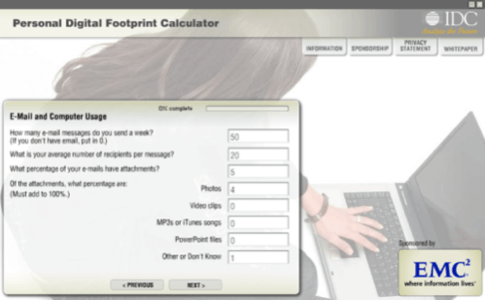Earlier this month, EMC released their findings regarding the digital universe in a publication entitled “The Diverse and Exploding Digital Universe.” Some of the research focused on mind-blowing figures – like the 281 billion GB size of the digital universe or the predicted size of the digital universe by 2011, nearly 1.8 zettabytes (1,800 exabytes). However, what really peaked our interest was information provided on your “Digital Shadow,” that is, all the digital information generated about an average person on a daily basis.

You may already be familiar with the term “digital footprint,” which you probably take to mean your online data trail. If asked to describe what would comprise this “footprint,” likely responses would include things like your social network profiles, your web site or blog, your photos shared on an online service, videos you uploaded to YouTube, perhaps even mentions of you in the local paper or your school’s web site. You may even go so far as to include information about you or your businesses that are public record.
Certainly those things are contributing factors to your digitally encoded self, however, this recent EMC-sponsored study discovered that your digital footprint includes far more than just the data related to individual actions.
Out of the 281,000,000,000 GB digital universe, each person’s contribution is about 45 GB, and out of that 45 GB, only about half of the digital footprint would be related to these “active” individual actions – taking pictures, making VoIP calls, uploading videos, downloading content, etc.
Awareness of those sorts of self-created data trails has been steadily increasing according to a recent PEW Internet report (Dec. 2007), with nearly half of all internet users (47%) having searched for information about themselves, up 22% from 2002.
But this new research shows that we need to be aware of much more than just online mentions. What we need to concern ourselves with now, is the other half of our digital footprint. This “ambient content,” the research team concluded, comprises of passive contributions, something termed as your “digital shadow.”
Your shadow includes things like images of you on a surveillance camera, your bank records, your retail and airline purchase records, your telephone records, your medical database entries, copies of hospital scans, information about your web searches, general backup data, information about credit card purchases, etc.
John Gantz, Chief Research Officer and Senior Vice President of IDC explains the digital shadow as simply “information about you,” but what’s surprising about this shadow, he explains, is that “for the first time your digital shadow is larger than the digital information you actively create about yourself.”
While for you this means being aware of the numerous places your information is stored to protect yourself from identity theft, for businesses, especially enterprise IT organizations that gather this information, it means a tremendous responsibility for the security, privacy protection, reliability and legal compliance of this information.
“Society is already feeling the early effects of the worlds digital information explosion. Organizations need to plan for the limitless opportunities to use information in new ways and for the challenges of information governance,” said Joe Tucci, EMC Chairman, President and CEO. “As peoples digital footprints continue growing, so too will the responsibility of organizations for the privacy, protection, availability and reliability of that information. The burden is on IT departments within organizations to address the risks and compliance rules around information misuse, data leakage and safeguarding against security breaches.”
If you’re interested in the current size of your own digital footprint, you can download a copy of the Personal Digital Footprint Calculator. This tool walks you through a questionnaire that calculates your impact based on the responses to questions about your computer usage, email usage, digital camera/camcorder usage, web downloading habits, potential surveillance areas, and geographical information, among other things. The questions do make you think about your online activities, but they may be hard to answer if you’re not really aware of your online activities or good at coming up with averages for things like “number of emails sent per week,” for example.
Digital Footprint Calculator

However, if you take the time to fill out the Digital Footprint Calculator correctly, you’ll be presented with your current “daily digital footprint,” in megabytes. You can then click “Start Ticker” to launch your own personal ticker that increments over time according to your digital information creation. You can even upload this, along with the .swf file, to your own web site and share your results with others.
Example Ticker (taking wizard defaults)

Having a digital shadow is not necessarily a bad thing, the study points out, as it’s what allows Amazon to make recommendations for you or display your “trustworthiness” as a seller on eBay, the downside is that, in many cases, erasing that shadow is still difficult or impossible: think about the Facebook user rebellion that took place when it was discovered how difficult/impossible it was to remove your profile from the service.
But there are other examples of where people have even less choice in the matter, like government-mandated traffic light cameras or citywide surveillance. And of course, your safety is at the mercy of credit card companies and the like – if they aren’t taking security seriously, your digital shadow can be snatched away from you while an identity thief goes on a a rampage with your good name.
In the long run, it will be up to businesses to adapt to these changes and protect their customer’s data. Those that don’t will pay as their clients take their business to safer, more protective businesses elsewhere. And for us, just being aware of our impact on the digital universe is a good place to start.










